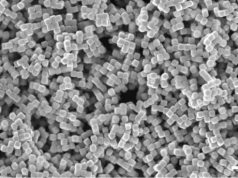This first version of a new layered perovskite solar cell already achieves an efficiency of more than 20 percent, rivaling many commercial solar cells. Flexible and easy to make, it can produce more than half a volt of electricity. Credit: Onur Ergen, UC Berkeley
Solar cells made from an inexpensive and increasingly popular material called perovskite can more efficiently turn sunlight into electricity using a new technique to sandwich two types of perovskite into a single photovoltaic cell.
Perovskite solar cells are made of a mix of organic molecules and inorganic elements that together capture light and convert it into electricity, just like today’s more common silicon-based solar cells. Perovskite photovoltaic devices, however, can be made more easily and cheaply than silicon and on a flexible rather than rigid substrate. The first perovskite solar cells could go on the market next year, and some have been reported to capture 20 percent of the sun’s energy.
In a paper appearing online today in advance of publication in the journal Nature Materials, University of California, Berkeley, and Lawrence Berkeley National Laboratory scientists report a new design that already achieves an average steady-state efficiency of 18.4 percent, with a high of 21.7 percent and a peak efficiency of 26 percent.
“We have set the record now for different parameters of perovskite solar cells, including the efficiency,” said senior author Alex Zettl, a UC Berkeley professor of physics, senior faculty member at Berkeley Lab and member of the Kavli Energy Nanosciences Institute. “The efficiency is higher than any other perovskite cell – 21.7 percent – which is a phenomenal number, considering we are at the beginning of optimizing this.”
“This has a great potential to be the cheapest photovoltaic on the market, plugging into any home solar system,” said Onur Ergen, the lead author of the paper and a UC Berkeley physics graduate student.
Find your dream job in the space industry. Check our Space Job Board »
The efficiency is also better than the 10-20 percent efficiency of polycrystalline silicon solar cells used to power most electronic devices and homes. Even the purest silicon solar cells, which are extremely expensive to produce, topped out at about 25 percent efficiency more than a decade ago.
The achievement comes thanks to a new way to combine two perovskite solar cell materials – each tuned to absorb a different wavelength or color of sunlight – into one “graded bandgap” solar cell that absorbs nearly the entire spectrum of visible light. Previous attempts to merge two perovskite materials have failed because the materials degrade one another’s electronic performance.
“This is realizing a graded bandgap solar cell in a relatively easy-to-control and easy-to-manipulate system,” Zettl said. “The nice thing about this is that it combines two very valuable features – the graded bandgap, a known approach, with perovskite, a relatively new but known material with surprisingly high efficiencies – to get the best of both worlds.”
Full-spectrum solar cells
Materials like silicon and perovskite are semiconductors, which means they conduct electricity only if the electrons can absorb enough energy – from a photon of light, for example – to kick them over a forbidden energy gap or bandgap. These materials preferentially absorb light at specific energies or wavelengths – the bandgap energy – but inefficiently at other wavelengths.
“In this case, we are swiping the entire solar spectrum from infrared through the entire visible spectrum,” Ergen said. “Our theoretical efficiency calculations should be much, much higher and easier to reach than for single-bandgap solar cells because we can maximize coverage of the solar spectrum.”
The key to mating the two materials into a tandem solar cell is a single-atom thick layer of hexagonal boron nitride, which looks like a layer of chicken wire separating the perovskite layers from one other. In this case, the perovskite materials are made of the organic molecules methyl and ammonia, but one contains the metals tin and iodine, while the other contains lead and iodine doped with bromine. The former is tuned to preferentially absorb light with an energy of 1 electron volt (eV) – infrared, or heat energy – while the latter absorbs photons of energy 2 eV, or an amber color.
The monolayer of boron nitride allows the two perovskite materials to work together and make electricity from light across the whole range of colors between 1 and 2 eV.
The perovskite/boron nitride sandwich is placed atop a lightweight aerogel of graphene that promotes the growth of finer-grained perovskite crystals, serves as a moisture barrier and helps stabilize charge transport though the solar cell, Zettl said. Moisture makes perovskite fall apart.
The whole thing is capped at the bottom with a gold electrode and at the top by a gallium nitride layer that collects the electrons that are generated within the cell. The active layer of the thin-film solar cell is about 400 nanometers thick.
“Our architecture is a bit like building a quality automobile roadway,” Zettl said. “The graphene aerogel acts like the firm, crushed rock bottom layer or foundation, the two perovskite layers are like finer gravel and sand layers deposited on top of that, with the hexagonal boron nitride layer acting like a thin-sheet membrane between the gravel and sand that keeps the sand from diffusing into or mixing too much with the finer gravel. The gallium nitride layer serves as the top asphalt layer.”
It is possible to add even more layers of perovskite separated by hexagonal boron nitride, though this may not be necessary, given the broad-spectrum efficiency they’ve already obtained, the researchers said.
“People have had this idea of easy-to-make, roll-to-roll photovoltaics, where you pull plastic off a roll, spray on the solar material, and roll it back up,” Zettl said. “With this new material, we are in the regime of roll-to-roll mass production; it’s really almost like spray painting.”
Source: University of California – Berkeley
Research Reference:
- Graded bandgap perovskite solar cells, Nature Materials, nature.com/articles/doi:10.1038/nmat4795











